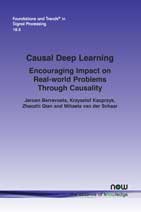Causal Deep Learning: Encouraging Impact on Real-world Problems Through Causality
By Jeroen Berrevoets, University of Cambridge, UK, jeroen.berrevoets@maths.cam.ac.uk | Krzysztof Kacprzyk, University of Cambridge, UK, kk751@cam.ac.uk | Zhaozhi Qian, University of Cambridge, UK, zhaozhi.qian@maths.cam.ac.uk | Mihaela van der Schaar, University of Cambridge and the Alan Turing Institute, UK, mv472@cam.ac.uk
Abstract
Causality has the potential to truly transform the way we solve a large number of real-world problems. Yet, so far, its potential largely remains to be unlocked as causality often requires crucial assumptions which cannot be tested in practice. To address this challenge, we propose a new way of thinking about causality-– we call this causal deep learning. Our causal deep learning framework spans three dimensions: (1) a structural dimension, which incorporates partial yet testable causal knowledge rather than assuming either complete or no causal knowledge among the variables of interest; (2) a parametric dimension, which encompasses parametric forms that capture the type of relationships among the variables of interest; and (3) a temporal dimension, which captures exposure times or how the variables of interest interact (possibly causally) over time. Our CDL framework enables us to precisely categorise and compare causal statistical learning methods. We use this categorisation to provide a comprehensive review of the CDL field. More importantly, CDL enables us to make progress on a variety of real-world problems by aiding us to leverage partial causal knowledge (including independencies among variables) and quantitatively characterising causal relationships among variables of interest (possibly over time). Our framework clearly identifies which assumptions are testable and which are not, so the resulting solutions can be judiciously adopted in practice. Our formulation helps us to combine or chain causal representations to solve specific problems without losing track of which assumptions are required to build these solutions, pushing real-world impact in healthcare, economics and business, environmental sciences and education, through causal deep learning.
Causal Deep Learning: Encouraging Impact on Real-world Problems Through Causality
Causality has the potential to truly transform the way we solve a large number of real-world problems. Yet, so far, its potential largely remains to be unlocked as causality often requires crucial assumptions which cannot be tested in practice. This monograph, entitled Causal Deep Learning (CDL), presents a new way of looking at causality.
The causal deep learning framework in this monograph spans three dimensions: (1) a structural dimension, which incorporates partial yet testable causal knowledge rather than assuming either complete or no causal knowledge among the variables of interest; (2) a parametric dimension, which encompasses parametric forms that capture the type of relationships among the variables of interest; and (3) a temporal dimension, which captures exposure times or how the variables of interest interact (possibly causally) over time.
The CDL framework used enables precise categorisation and comparison of causal statistical learning methods. This categorisation is used to provide a comprehensive review of the CDL field. More importantly, CDL enables progress on a variety of real-world problems by aiding partial causal knowledge (including independencies among variables) and quantitatively characterising causal relationships among variables of interest (possibly over time). The framework used clearly identifies which assumptions are testable and which are not, so the resulting solutions can be judiciously adopted in practice. This formulation helps to combine or chain causal representations to solve specific problems without losing track of which assumptions are required to build these solutions, pushing real-world impact in healthcare, economics and business, environmental sciences and education, through causal deep learning.
